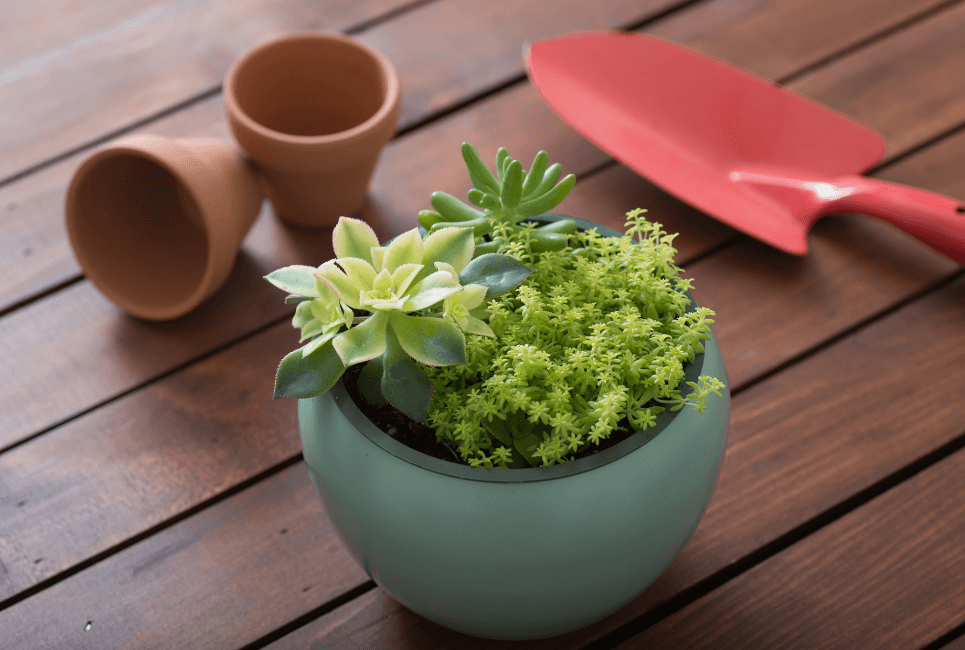Elegant, resilient, and extremely low-maintenance, succulents are a great way to brighten up a space. Whether you grow them in outdoor pots to complement your garden or make the most of their decorative qualities on an indoor windowsill, here’s everything you need to know about potting succulents.
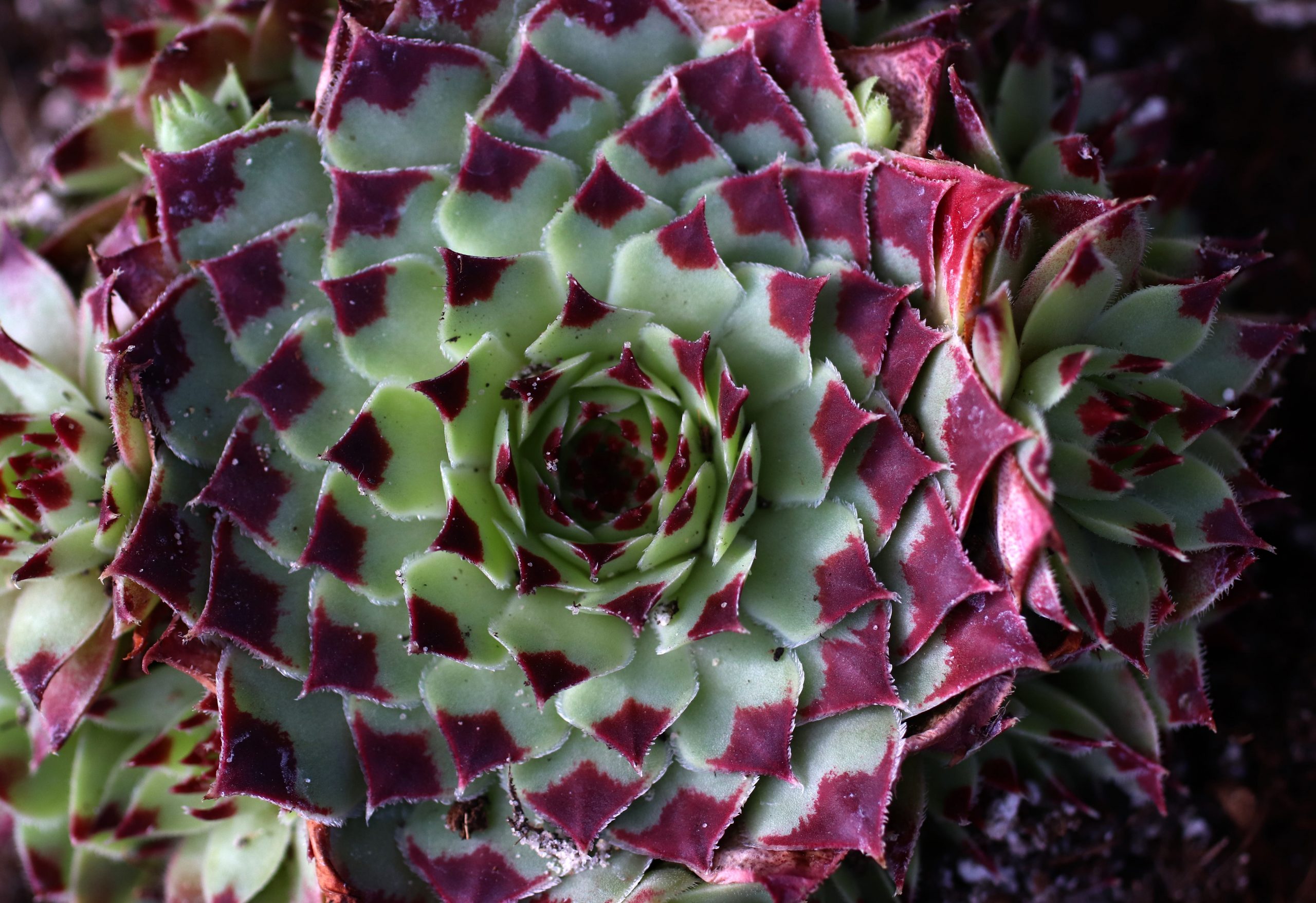
What are Succulents?
Succulents are plants that have thick and fleshy tissues, designed to store water. Some succulents store this in their leaves, some hold moisture in their stems, while others store it in their roots.
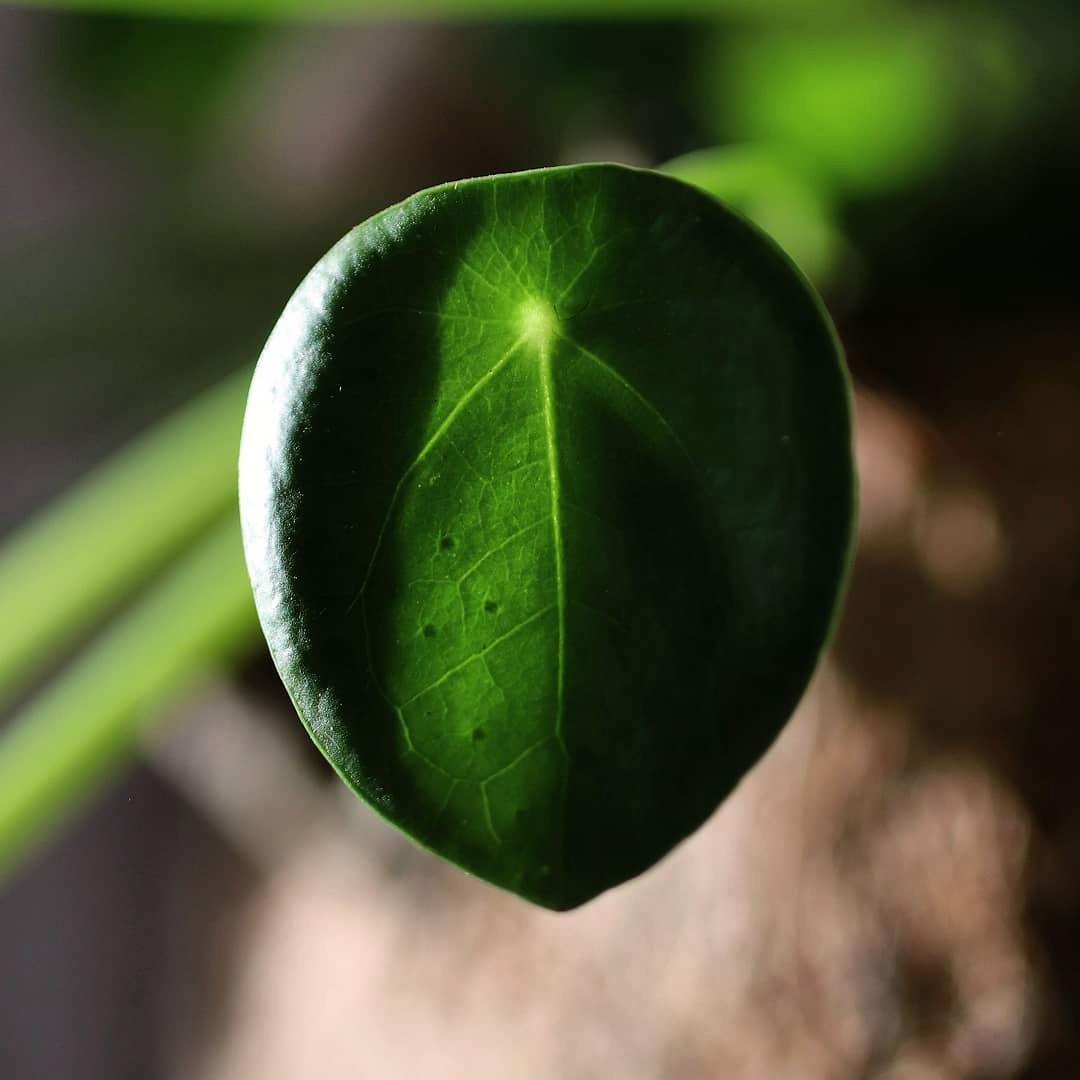
Succulents come in an incredible diversity of types, shapes, sizes, and colors, with most grown for their foliage rather than their flowers. However, in order to cope with their dry and arid native habitat, all succulents share the amazing ability to store moisture.
This means that succulents don’t need quite as much attention when compared to other plants, especially in terms of watering, making them perfect for growing in pots.
Which Succulents Grow Best in Pots?
Succulents can be found in more than 60 different plant families, meaning that there are thousands of succulent types out there.
Just about every succulent will do well in a pot, but if you’re looking for something that’s especially easy to care for, here are a few options:
- Aloe Vera
- Echeveria
- String of Pearls
- Hen and Chicks
- Agave
- Haworthia
When to Pot Succulents
Chances are, your succulent is already in a pot, so how do you know when it’s time to move it into a new one?
As is usually the case with potted plants, check the bottom of the pot. If you notice that roots have started to emerge through, then this means that it’s time for a new pot.
Another way to tell whether or not your succulent needs a new pot is by watering it – the water should thoroughly soak through all of the soil within. If it drains too quickly, then this is a sign that the soil is compacted, meaning that the plant would benefit from a new pot with looser and more aerated soil.
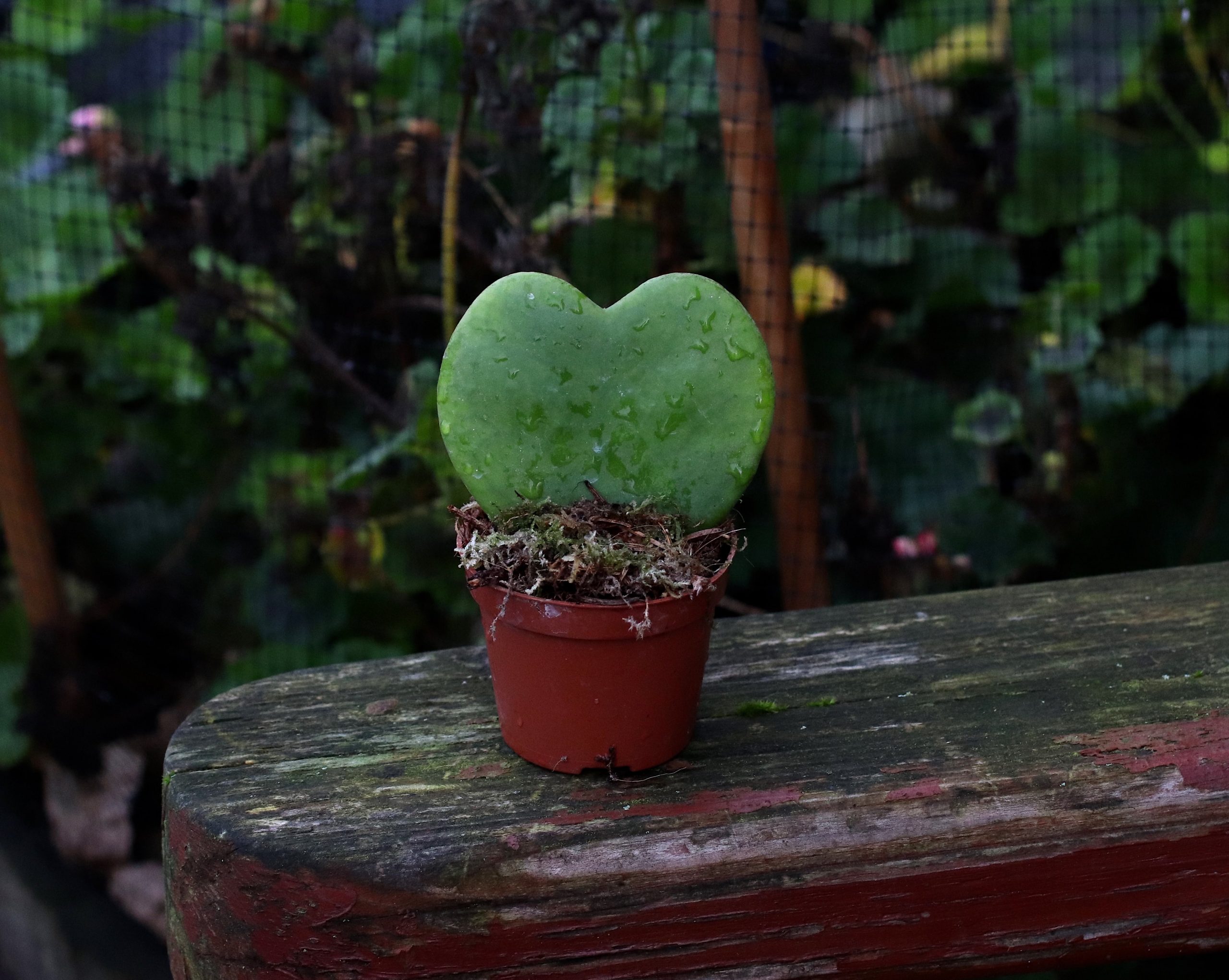
The time of year matters too…
Most succulents go through a period of dormancy, where they stay alive but without growing. For some, this will be in the winter, while others go dormant in the summer. Either way, avoid potting your succulent while it is dormant.
This usually means that spring and fall are the best times of the year for potting a succulent.
The exception to this would be if your succulent is in flower. Repotting it will likely interfere with the blooming process, meaning that it will lose its flowers. If you want the flowers to remain on your plant, hold off on potting until the flowers have naturally died off.
Choosing a Pot for Your Succulents
You may be tempted to go for a pot-based solely on how it looks, but there are a few other important factors that you need to take into consideration too…
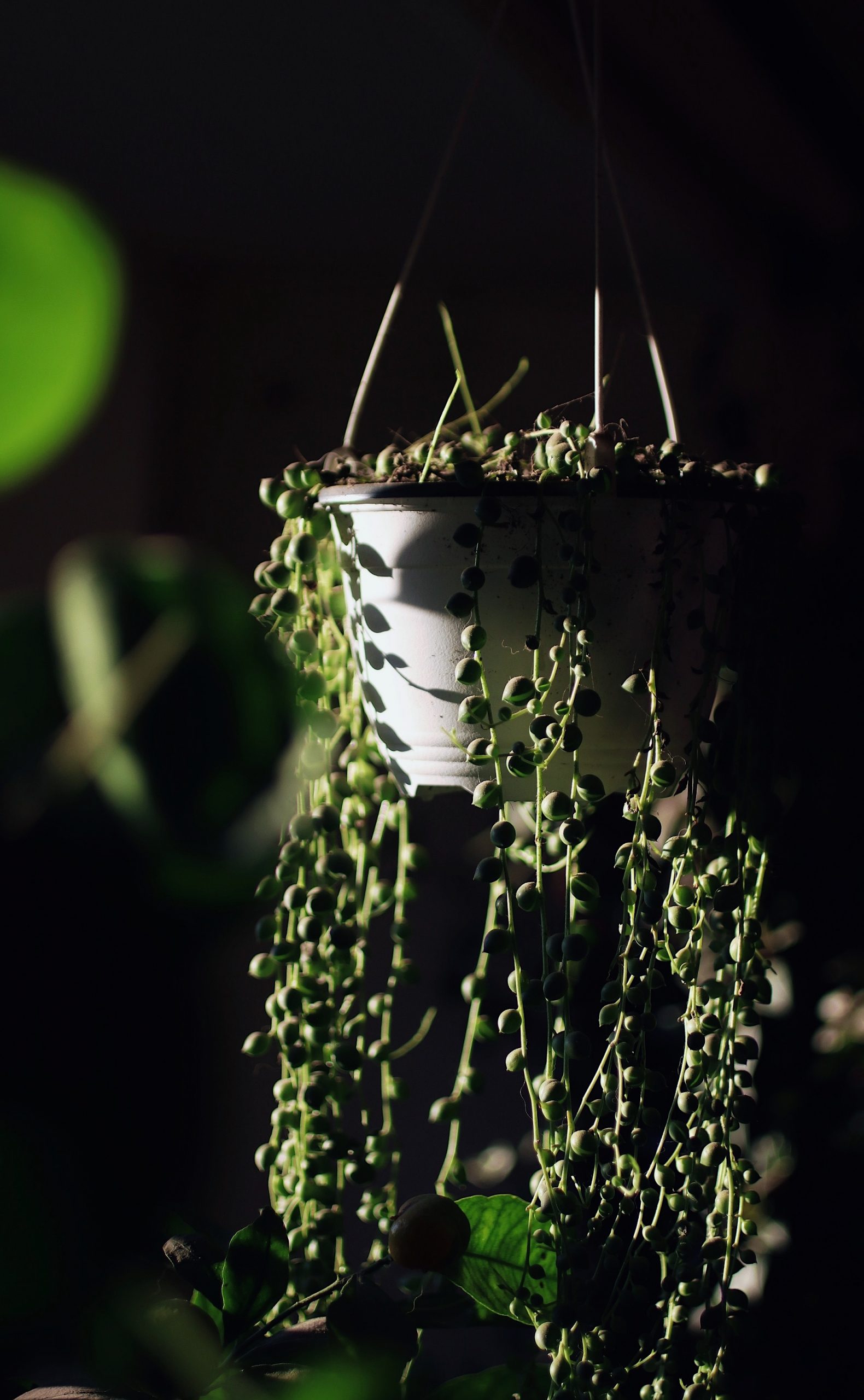
Pot Size
Succulents usually have shallow roots that take time to strengthen up as they grow. If the roots are given too much space, they will spread too quickly and the plant itself won’t be able to keep up with this, making shallow pots better than deep pots.
Pick a depth that gives the roots just a little room to grow, but not too much.
In terms of circumference, you want something that’s about 5%-10% larger than your plant – don’t give your succulents more than a couple of inches of space between them and the sides of their pot.
Pots that are too large will also hold too much moisture, which you want to avoid when growing succulents.
Pot Material
From terracotta to plastic to wood, plant pots can be made from a wide range of different materials, and each one will have its pros and cons.
Here’s a quick guide to some of the most popular pot materials for succulents:
- Terracotta/Ceramic – these tend to be the most breathable pot materials, meaning fantastic air circulation and water drainage for your succulents. However, large pots can end up quite heavy, especially when they’ve been freshly watered, so aren’t suitable for those who plan on moving their succulents around their home or garden.
- Plastic – pots made from plastic are light and generally quite sturdy. Although breathability isn’t as good when compared to terracotta or ceramic, drainage holes will help to make up for this.
- Wood – wood is definitely eye-catching when used as a succulent pot, and the way in which the material stays cool makes it great for hotter climates. However, wood also retains quite a bit of moisture, which could make the soil within too damp for some succulents.
- Glass – glass is another material that has huge visual appeal for indoor succulents, but it comes with a number of downsides – drainage is usually poor, the material isn’t very breathable, and dirt and water deposits quickly build up. Glass also breaks very easily, which could cause serious damage to your succulents.
Drainage Holes
Succulents don’t like to be sitting in damp soil. A lack of drainage could lead to a number of different problems, such as:
- Stem and root rot
- Scab
- Fungal diseases
This is why drainage holes are extremely beneficial when growing succulents – they allow moisture to drain away, giving the plant roots time to breathe and absorb oxygen.
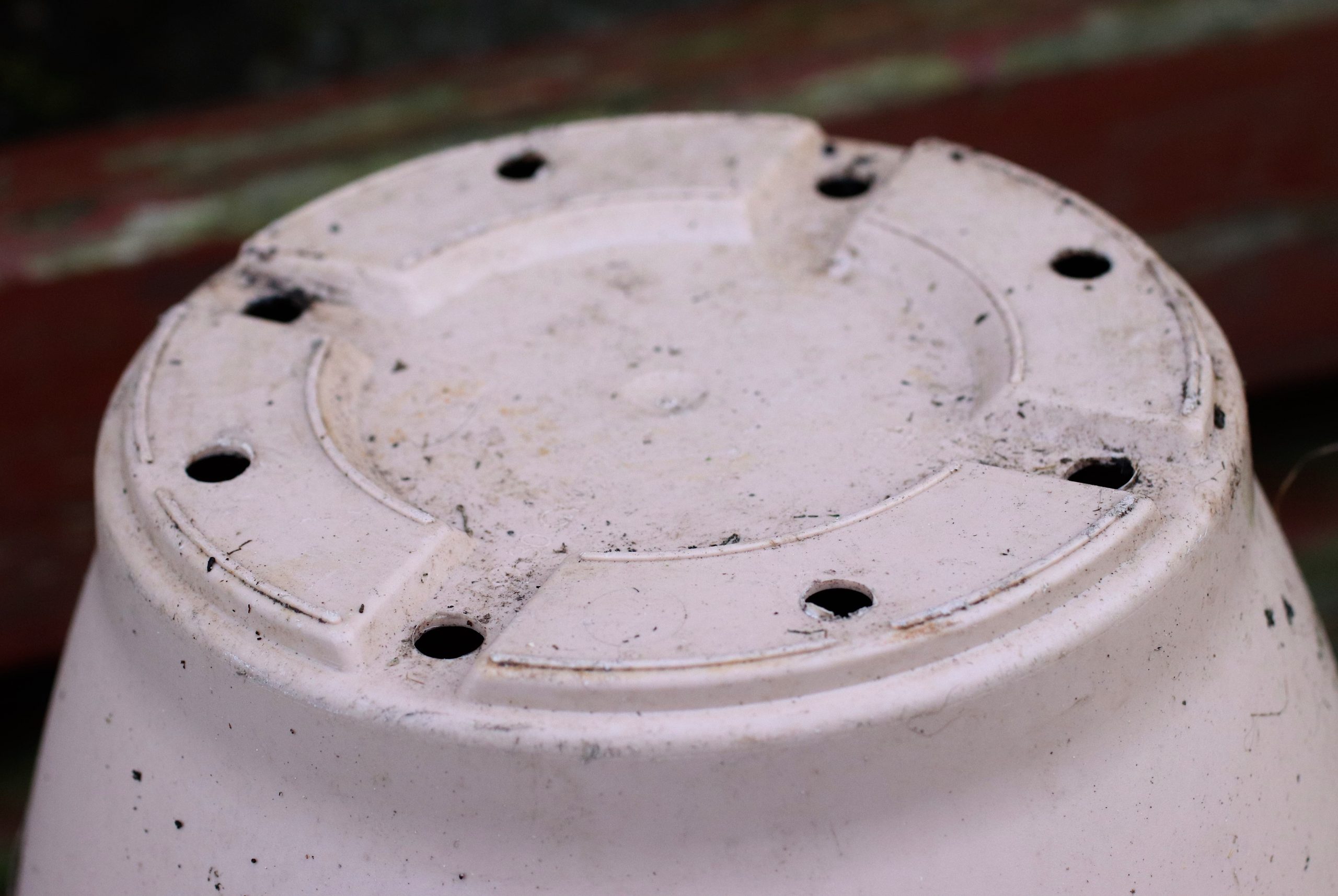
However, if you’ve already got a pot without drainage holes that you would like to use for your succulents, you have a few options:
- Double pot – place a smaller pot with drainage holes into your pot without drainage holes, placing gravel in the outer pot.
- Manually drain excess water – if you’ve given your plant a good watering, wait for a few minutes before manually tipping the pot over to pour away any excess water.
- Controlled watering – carefully monitor the amount of water you give your plant – it only needs enough for the top two to three inches of soil to be saturated. Then, wait until this has fully dried before watering again.
Hanging Pots
If you’re looking for a pot for a trailing succulent, then hanging pots are worth considering. These will help to really showcase your plant, highlighting that lush cascade of foliage.
Trailing succulents will do well in regular pots too, just make sure that the trailing foliage isn’t positioned in a way that leaves them vulnerable to damage.
Style
While you will want to choose a pot that blends in well with your decor, don’t forget to also keep the physical characteristics of your plant in mind when choosing a design.
Look for a design that complements the appearance of your succulent, whether this may be in terms of pattern or color.
If you can’t quite decide, a simple white ceramic pot or classic terracotta pot usually work well with everything!
Choosing a Potting Mix for Your Succulents
Since succulents don’t do well when their roots remain moist for long periods of time, the potting mix you use needs to be loose and well-draining.
While some may be able to get away with just slightly amending regular soil, this isn’t ideal – regular soil is designed to retain moisture, whereas you want the opposite of this for your succulents.

The soil you use still needs to provide nourishment, but should encourage any water to quickly drain away.
If you want a quick and easy option, purchase a pre-made soil mix designed for either succulents or cacti. These are usually more expensive than regular soil, but they will give your succulents everything they need.
Alternatively, you also have the option of making your own succulent potting mix…
How to Make Your Own Potting Mix for Succulents
Making your own succulent potting mix is cheaper than buying pre-mixed soil, and it also means that you have full control over the ingredients you use. This enables you to make small adjustments for different succulent varieties – even though they all need well-draining soil, they will each have their own individual requirements too.
To start with, you’ll need some regular soil. Pick a soil that’s as light as possible – don’t use anything that’s specifically formulated to retain moisture.
You’ll then need to mix your soil with one or more of the following:
- Coarse sand – succulents do best when given a sandy mix. There are a few types of sand available, but coarse sand is what you need – this ensures maximum drainage. Don’t be tempted to use sand from a beach, as there could be harmful bacteria lurking within.
- Perlite – this is a very lightweight material that increases drainage and soil aeration, making it great for succulents. It may look like tiny balls of styrofoam, but perlite is actually made from natural materials.
- Pumice – this is another natural material that also helps to improve drainage, but does retain some moisture and nutrients too.
- Turface – fantastic for aerating the soil so that the roots can access enough oxygen, turface is a pebble-like substrate that can either be mixed into the soil or used as a top dressing.
When it comes to how much of each to use, this varies. Only trial and error will tell you what’s best for your individual plants in their specific environment, but most growers will use about 50% soil, 30% sand, and 20% perlite or pumice.
Add your chosen ingredients into a large container, or even a wheelbarrow, and mix everything together well. While you can use a trowel to do this, you’ll find it faster and more efficient to just use your hands!
If you don’t end up using everything you’ve made, you can then store it in an airtight container for future use.
Removing Succulents from Old Pots
Be gentle when removing a succulent from an old pot. Most of the time, its roots will have emerged through the drainage holes – you’ll need to turn the pot upside down and carefully tease the plant out, taking care not to snap or damage any of its roots.
Gently squeezing the pot around the sides can help to loosen the plant. You could also use a stick to ease the plant out of any tight spaces that your fingers can’t reach.
Once your succulent is out, be careful not to completely remove all of the soil – you don’t want the roots to be bare. Instead, give it a gentle shake to help loosen it.
If the root system of your succulent is particularly unruly, you can give it a quick trim, but this isn’t usually necessary.
Your succulent will now be ready for its new pot!
How to Plant Succulents in a Pot
Half-fill your pot with your chosen potting mix, but don’t pat it down and compact it. It should remain as light and fluffy as possible.
Place your succulent into the pot, and then lightly fill in with more potting mix. Again, don’t tamp the soil down as you would for other plants.
While non-succulent plants require a watering immediately after planting, don’t be too hasty in doing this for a succulent, unless its soil was particularly dry when you were planting it.
If the roots of your succulent were already damp, then wait for a few days before giving it some water because you don’t want to end up overwatering it.
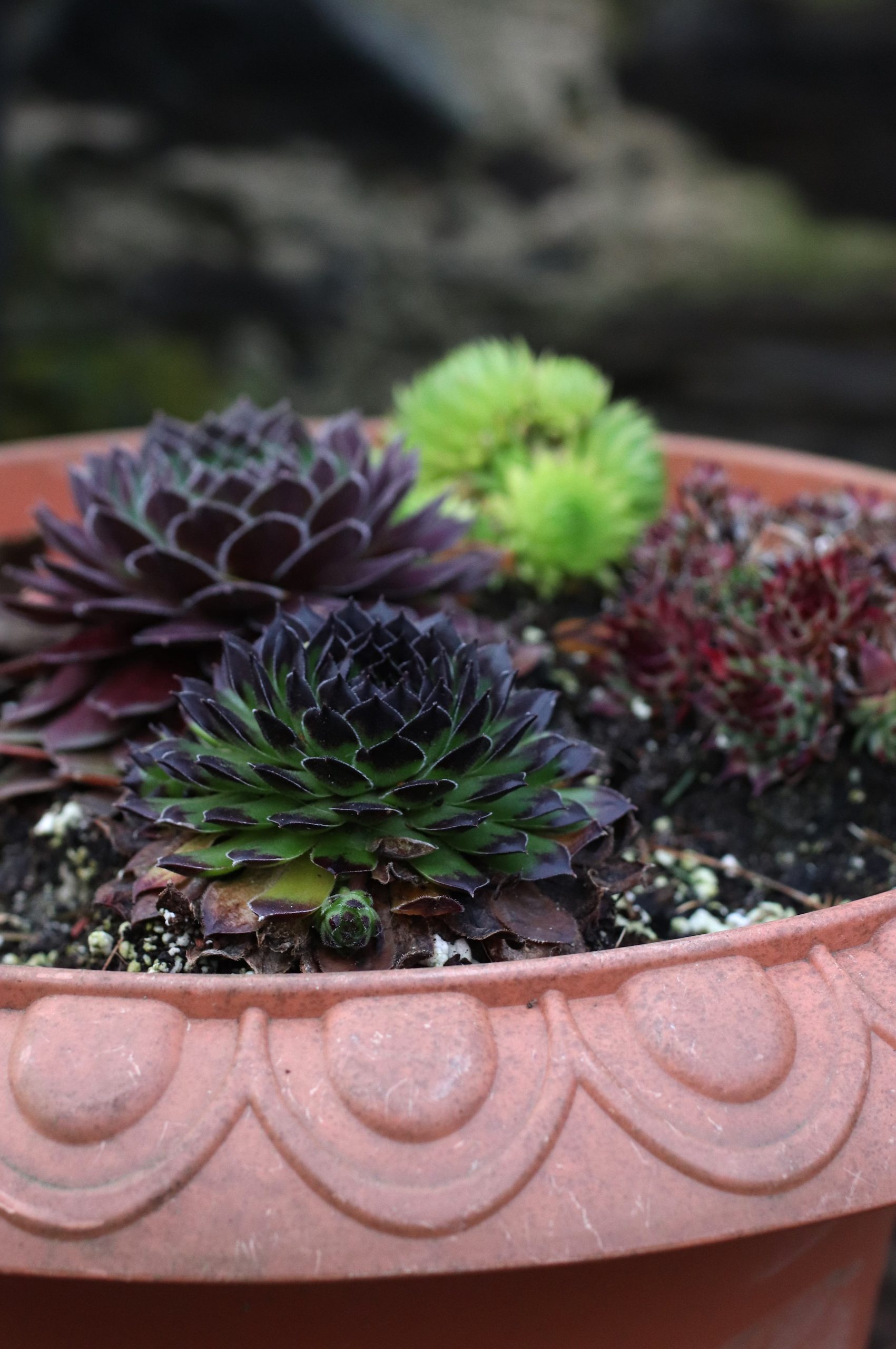
Planting a Succulent Arrangement
Whether you’re planning a small and elegant succulent bowl or a large and extravagant succulent container garden, succulent arrangements are full of texture, color, and drama.
While you could use multiple specimens of the same plant in a succulent arrangement, most gardeners tend to mix and match different succulents to really create a visual impact. Try to pick succulents that complement each other, not only in terms of appearance, but also when it comes to size.
Once you’ve filled your chosen container with your potting soil, it’s time to have some fun playing with different arrangements. Set each succulent into your potting soil but don’t properly plant it yet – this gives you the opportunity to move each plant around to create the perfect arrangement.
A general rule of thumb is to put taller succulents at the back, lower-growing varieties at the front, and trailing succulents at the sides. However, don’t be afraid to mix things up a bit and add your own personality to your arrangement.
When it comes to spacing, try to leave about an inch or so in between each succulent. Remember, succulents don’t need much space – this is exactly why they work so well together in an arrangement.
If you plant them together quite tightly, they’ll likely still do well, but won’t grow at the rate that they would have done if they had been given more space.
Once you’ve decided on their final position, you can start planting them in. Begin in the middle and work your way out.
You can then add some decorative gravel or aquarium stones to the top of your soil to give the arrangement even more ornamental appeal.
Only water your new arrangement if the plants were especially dry before going in. Otherwise, wait a few days before watering.
Fertilizing Potted Succulents
Since succulents have very shallow root systems, they aren’t able to access a wide range of nutrient sources. This is even more so the case when a succulent is grown in a pot, compared to one being grown in the ground.
In order for your succulents to really thrive, you’ll need to regularly feed them.
A balanced, all-purpose fertilizer is all you need. You can either make your own, such as by mixing up some manure tea, or purchase a succulent-specific fertilizer.
Either way, aim to fertilize your potted succulents once a month during their growing season, cutting this back to once every three months when the plant is dormant.
Summary
While succulents may be pretty easy to care for, you do still need to get things right when it comes their pots. From choosing the right pot size and material to mixing together the best potting soil, understanding how to pot succulents is what will ensure that yours does nothing but beautifully thrive.
Q&A
Can succulents be planted in rocks?
You may have seen decorative features with succulents growing from rocks or pieces of driftwood, but most of these usually have a small amount of soil added in beneath as well. Yes, succulents are capable of growing in dry areas where other plants fail, but they do still need some soil to thrive – they wouldn’t be able to survive on rocks alone.
Should I mist the foliage of my potted succulent?
No, definitely not. Succulents are native to dry and arid regions where humidity is naturally low, such as a desert. This is why they’re so good at storing water in their plant tissues, since there isn’t any water in the air for them to absorb. Misting your succulents increases humidity, which can lead to rot. The only exception is if you are propagating succulents – they will need to be misted until those young roots have strengthened up.
Do potted succulents need to be watered from below?
Watering from below involves placing a pot in a container of water for a set period of time, allowing the soil and roots to soak up all they need from beneath. While your succulents will do fine with just being watered from above, watering from below has the added advantage of promoting root growth, as the roots will stretch downwards once they sense that there is water there.
Can potted succulents survive the winter?
It all depends on the variety you choose. While potted succulents are definitely more vulnerable to cold damage than those grown in the ground, there are many hardy varieties out there that will do well in the winter.
Do succulents need to have rocks placed around them in their pot?
This is a common sight, but it’s not strictly necessary. However, placing rocks or decorative pebbles in your pot, over the top of your potting mix and around your plant, will help to encourage drainage even further, while making the plant even more ornamental.
Continue reading:
